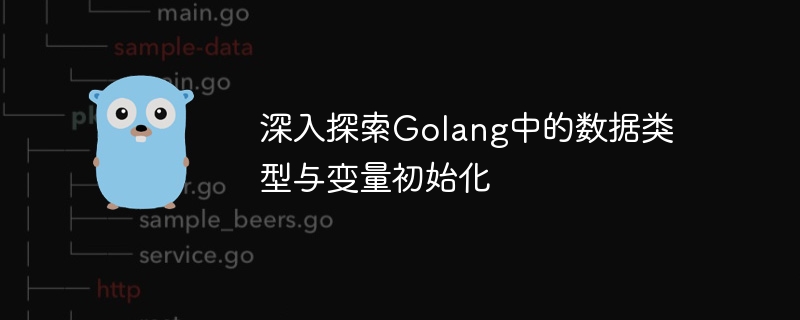

In-depth exploration of data types and variable initialization in Golang
In the Go language, the initialization of data types and variables is a problem we often need to face. Correct data types and initialization of variables ensure the robustness and correctness of your program. In this article, we will delve into the knowledge of data types and variable initialization in Golang and give specific code examples.
The basic data types in Golang include bool, int, float, string, etc. The initialization of these data types is very simple and can be initialized directly using assignment operations. Here are a few examples:
var b bool // 声明一个bool类型变量b,未初始化,默认值为false var i int // 声明一个int类型变量i,未初始化,默认值为0 j := 10 // 声明并初始化一个int类型变量j,值为10 var f float32 // 声明一个float32类型变量f,未初始化,默认值为0 g := 3.14 // 声明并初始化一个float64类型变量g,值为3.14 var s string // 声明一个string类型变量s,未初始化,默认值为空字符串 t := "Hello Go" // 声明并初始化一个string类型变量t,值为"Hello Go"
Arrays and slices are data structures used to store multiple elements of the same type in Golang . They are initialized slightly differently.
The array can be initialized using array literals or loops. Here are a few examples:
var a [3]int // 声明一个长度为3的int类型数组a,未初始化,默认值为[0,0,0]
b := [4]string{"one", "two", "three", "four"} // 声明并初始化一个长度为4的string类型数组b
c := [...]int{1, 2, 3, 4, 5} // 声明并初始化一个长度根据初始化元素个数自动确定的int类型数组c
for i := 0; i < len(a); i++ {
a[i] = i + 1 // 使用循环给数组a赋值
}The slice can be initialized using slice literals, or you can use the make function to create a slice. Here are a few examples:
d := []int{1, 2, 3, 4, 5} // 声明一个int类型切片d,并赋予初始值
e := make([]string, 3) // 声明一个长度为3的string类型切片e,未初始化,默认值为["","",""]
f := make([]float64, 5, 10) // 声明一个长度为5,容量为10的float64类型切片f,未初始化,默认值为[0,0,0,0,0]Structure is a custom complex type in Golang that can contain multiple fields of different types. The structure can be initialized using a structure literal or using the new function to create a structure pointer. Here are a few examples:
type person struct {
name string
age int
}
var p1 person // 声明一个person类型变量p1,未初始化,默认值为{name:"", age:0}
p1.name = "Alice" // 给结构体字段赋值
p1.age = 25
p2 := person{"Bob", 30} // 声明并初始化一个person类型变量p2
p3 := person{
name: "Charlie",
age: 35,
}
p4 := new(person) // 声明一个person类型变量p4,并分配内存,返回的是指向新分配内存的指针
p4.name = "Dave"
p4.age = 40In addition to basic data types, arrays, slices and structures, there are other collection types in Golang, Such as map and channel. They also have their own initialization methods.
The initialization of map uses the make function to create an empty map and assign values using key-value pairs. Here is an example:
m := make(map[string]int) // 声明一个string到int的映射类型变量m,并分配内存 m["apple"] = 1 // 给映射类型变量m赋值 m["banana"] = 2 m["cherry"] = 3
Channel initialization uses the make function to create an unbuffered or buffered channel. The following are two examples:
ch1 := make(chan int) // 声明一个无缓冲的int类型channel变量ch1 ch2 := make(chan string, 10) // 声明一个容量为10的string类型channel变量ch2,具有缓冲功能
Through the above examples, we understand the initialization methods of data types and variables in Golang, including the initialization of basic data types, arrays, slices, structures, maps, and channels. Properly initializing data types and variables can greatly improve the robustness and correctness of your program. In actual programming, we can choose a suitable initialization method according to specific needs to improve the readability and maintainability of the code.
The above is the detailed content of In-depth exploration of data types and variable initialization in Golang. For more information, please follow other related articles on the PHP Chinese website!
 What are the data types?
What are the data types?
 How to define variables in golang
How to define variables in golang
 What are the data conversion methods in golang?
What are the data conversion methods in golang?
 What are the commonly used libraries in golang?
What are the commonly used libraries in golang?
 What is the difference between golang and python
What is the difference between golang and python
 How to insert page numbers in ppt
How to insert page numbers in ppt
 What is the transfer limit of Alipay?
What is the transfer limit of Alipay?
 pycharm open new file method
pycharm open new file method




